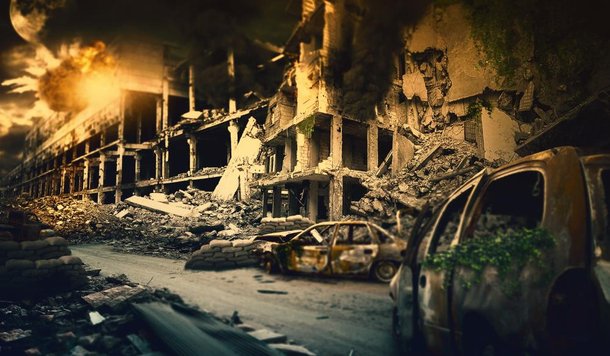Desde criancinha aprendemos o quão poderosas são as armas nucleares. Somos apresentados aos terríveis bombardeios de Hiroshima e Nagasaki, no Japão, e percebemos o imenso potencial destrutivo deste tipo de armamento.
Quando uma bomba nuclear explode, a pancada não fica só ali no local de origem: além de destruir tudo em quilômetros ao seu redor, também há risco de morte por radiação nas proximidades, além do impacto no meio-ambiente. E se uma bomba é ruim, o que seria de nós se rolasse uma verdadeira guerra nuclear? Será que existiria um lugar na Terra onde poderíamos ficar em segurança?
O lugar mais seguro em caso de guerra nuclear
 Réplica da ogiva nuclear “Fatman”, a bomba atômica lançada em Nagasaki. (Fonte: U.S. Department of Defense/Wikimedia Commons)
Réplica da ogiva nuclear “Fatman”, a bomba atômica lançada em Nagasaki. (Fonte: U.S. Department of Defense/Wikimedia Commons)
Desde a recente invasão da Rússia à Ucrânia, armas nucleares voltaram a ser um assunto bastante debatido pelas autoridades e por civis em todo o mundo. Mesmo sem o uso de bombas nucleares, é visível o rastro de destruição e desespero causado por uma guerra.
O combate entre as tropas russas e ucranianas também levantou o seguinte questionamento: qual seria o destino da humanidade caso os Estados Unidos e a Rússia iniciassem uma guerra nuclear? Ambos os países são grandes potências militares e rivais de longa data, mesmo com o fim da Guerra Fria. Precisaríamos todos nos esconder em abrigos nucleares?
A melhor aposta para quem quisesse fugir do impacto da disputa com armas nucleares seria provavelmente se refugiar na Antártica. Além de estar longe de tudo, sendo um local bastante isolado do resto do mundo, o Tratado da Antártida baniu o uso de armas de nucleares na região, tida como um território neutro e pacífico dedicado à pesquisa.
 As Ilhas Marshall já foram local de testes de bombas nucleares (Fonte: Library of Congress/Wikimedia Commons)
As Ilhas Marshall já foram local de testes de bombas nucleares (Fonte: Library of Congress/Wikimedia Commons)
Se viajar para um lugar tão distante (e tão frio) está fora de cogitação, outro local que provavelmente seria seguro é o arquipélago de Kiribati, localizado ao centro do oceano Pacífico. Outra opção viável seriam talvez as Ilhas Marshall, uma república vizinha de Kiribati que curiosamente no ado foi área de testes de bombas nucleares. Os locais são bastante isolados, sendo rodeados por milhares e milhares de quilômetros de oceano.
Por fim, mas não menos importantes, duas nações potencialmente se destacariam no quesito produção de alimentos. Segundo Alan Robock, professor na Universidade Rutgers, nos Estados Unidos, tanto a Argentina quanto a Austrália teriam certa vantagem por produzirem grandes quantidades de alguns grãos mais resistentes, como o trigo.
Impacto na humanidade
Ainda que pudéssemos tentar “fugir” de todo o caos, caso uma guerra nuclear realmente aconteça em algum momento no futuro, tal evento colocaria em risco o futuro da humanidade e causaria um colapso na civilização. Obviamente, aqueles mais próximos dos locais bombardeados teriam muito mais risco de morte, tanto pelo impacto das bombas quanto pela radiação deixada pelas explosões.
 Uma guerra nuclear poderia causar um colapso na civilização. (Fonte: Shutterstock)
Uma guerra nuclear poderia causar um colapso na civilização. (Fonte: Shutterstock)
Mas mesmo aqueles mais distantes também estariam em risco: após os ataques, as explosões levantariam bastante fuligem, potencialmente bloqueando a entrada dos raios solares na atmosfera por períodos de até mais de uma década. Isto impactaria diretamente em todo o meio-ambiente, acabando com grande parte da flora e da fauna no planeta e tornando o clima mais frio.
A humanidade, obviamente, também seria fortemente impactada com bilhões de pessoas ando frio e fome, acarretando em milhões, talvez até bilhões, de mortos em todo o mundo, além do colapso da economia mundial. Torçamos então para que as guerras nucleares não venham a acontecer, pois suas consequências seriam catastróficas.
Fonte: MegaCurioso.
